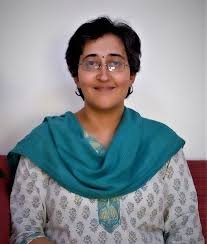Delhi New Cm Atishi Biography: Age, Education, Politics, Family, Husband.
Introduction
On September 21, 2024, Delhi witnessed a historic moment as Atishi Marlena Singh, commonly known as Atishi, took oath as the new Chief Minister. At 43 years old, she became the youngest woman to hold this prestigious position, succeeding Arvind Kejriwal after resigning after his release on bail. This article looks into the life, career, and achievements of Atishi, exploring her journey from an education reformer to the leader of India’s capital city.
Early Life and Background
Birth and Family
Born on June 8, 1981, in Delhi, Atishi grew up in an environment steeped in academic excellence and progressive ideologies. Her parents, Tripta Wahi and Vijay Singh, both professors at Delhi University, played a significant role in shaping her worldview and values.
The Significance of “Marlena”
Atishi’s middle name, “Marlena,” carries a unique story. It’s a fusion of “Marx” and “Lenin,” reflecting her parents’ admiration for communist leaders and their leftist ideologies. This name would later become a topic of discussion and eventual change in her political career.
Early Education
Atishi’s educational journey began at Springdales School in New Delhi, a institution known for its emphasis on holistic development and social responsibility. This foundation would prove crucial in her future endeavors in public service and education reform.
Higher Education and Academic Achievements
Undergraduate Studies
After completing her schooling, Atishi pursued higher education at the prestigious St. Stephen’s College, Delhi University. Here, she obtained a degree in History, laying the groundwork for her analytical skills and deep understanding of societal structures and changes.
The Rhodes Scholarship
Atishi’s academic excellence was recognized internationally when she was awarded the highly competitive Rhodes Scholarship. This prestigious award opened doors to one of the world’s most renowned educational institutions and marked a significant milestone in her academic journey.
Oxford University
At the University of Oxford, Atishi pursued a Master’s degree in Educational Studies. This program allowed her to delve deep into educational policies, systems, and reforms – knowledge that would prove invaluable in her future role in Delhi’s government. Her time at Oxford also exposed her to global perspectives on education and governance, further shaping her vision for public service.
Early Career and Entry into Politics
Grassroots Work
After returning from Oxford, Atishi immersed herself in grassroots-level work, particularly focusing on education and rural development. She worked on various projects across India, gaining firsthand experience of the challenges faced by marginalized communities and the impact of effective education policies.
Joining the Aam Aadmi Party
Atishi’s passion for social change and governance reform led her to join the Aam Aadmi Party (AAP) in its early days. The party’s focus on anti-corruption and citizen-centric governance aligned well with her ideals. She quickly became an integral part of the party’s think tank, contributing significantly to policy formulation, especially in the education sector.
Contributions to Delhi’s Education Sector
Advisor to the Education Minister
One of Atishi’s most significant roles was serving as an advisor to Manish Sisodia, the then Education Minister of Delhi. In this capacity, she was instrumental in conceptualizing and implementing several groundbreaking education reforms that transformed Delhi’s public education system.
Key Initiatives and Reforms
- Infrastructure Improvement: Oversaw the renovation and upgrading of government school buildings, creating conducive learning environments.
- Teacher Training Programs: Implemented comprehensive training programs to enhance teaching methodologies and skills.
- Curriculum Overhaul: Worked on revamping the curriculum to make it more relevant and engaging for students.
- Parent-Teacher Engagement: Introduced initiatives to increase parental involvement in children’s education.
- Technology Integration: Spearheaded efforts to incorporate technology in classrooms, preparing students for the digital age.
Impact and Recognition
Under Atishi’s guidance, Delhi’s government schools saw remarkable improvements in infrastructure, teaching quality, and student outcomes. These reforms garnered national and international attention, with several states in India looking to replicate Delhi’s education model.
Political Career and Rise to Chief Minister
Electoral Politics
Atishi’s transition from a behind-the-scenes policy expert to a frontline politician came when she contested the 2019 Lok Sabha elections from the East Delhi constituency. Although she didn’t win, her campaign was noted for its focus on issues and clean politics.
Member of Legislative Assembly
In the 2020 Delhi Legislative Assembly election, Atishi won from the Kalkaji constituency, marking her entry into the Delhi Assembly. This victory was a testament to her growing popularity and the public’s recognition of her work in the education sector.
Ministerial Responsibilities
As an MLA, Atishi took on several key responsibilities in the Delhi government. She continued her work in the education sector while also contributing to other areas of governance, showcasing her versatility as a leader.
Succession to Chief Ministership
The political landscape of Delhi underwent a significant change in 2024 when Arvind Kejriwal stepped down as Chief Minister. Atishi, with her proven track record and growing stature within the party, emerged as the natural choice to lead the government.
Chief Ministership: Vision and Challenges
Taking Oath
On September 21, 2024, Atishi took oath as the Chief Minister of Delhi, creating history as the youngest woman to hold this position. The oath-taking ceremony was attended by several AAP leaders, including Saurabh Bhardwaj, Gopal Rai, and Kailash Gahlot, who were also sworn in as part of her cabinet.
Key Portfolios
As Chief Minister, Atishi took charge of crucial portfolios:
- Education: Continuing her passion for educational reform
- Finance: Managing the economic policies of the capital
- Public Works Department (PWD): Overseeing infrastructure development
Vision for Delhi
Atishi’s vision for Delhi encompasses:
- Continuing and expanding educational reforms
- Focusing on sustainable urban development
- Improving public healthcare systems
- Enhancing public transportation and reducing pollution
- Promoting women’s safety and empowerment
Challenges Ahead
As the new Chief Minister, Atishi faces several challenges:
- Managing the complex relationship between the Delhi government and the central government
- Addressing the city’s persistent air pollution problem
- Balancing development needs with environmental concerns
- Continuing to improve public services amidst budget constraints
- Navigating the political landscape as a young leader
Personal Life and Interests
Family Background
Atishi comes from a family of intellectuals and public servants:
- Father: Vijay Singh, a retired IAS officer known for his integrity and administrative skills
- Mother: Tripta Wahi, a respected social activist and author who has influenced Atishi’s social consciousness
Marriage and Personal Choices
Atishi is married to Praveen Singh, an entrepreneur and educationist. The couple met while working on a development project in Madhya Pradesh, bonding over their shared passion for social change. They have chosen to focus on their respective careers in public service and do not have children.
Interests and Hobbies
Beyond her political and administrative responsibilities, Atishi is known to be an avid reader with a particular interest in history and public policy. She is also passionate about environmental conservation and often participates in community initiatives focused on sustainability.
Controversies and Challenges
The “Marlena” Controversy
In 2019, during her Lok Sabha election campaign, Atishi dropped her surname “Marlena” to avoid any misunderstanding about her religious identity. This move sparked discussions about identity politics and the challenges faced by politicians with unconventional names.
Opposition Criticism
As a prominent face of the AAP, Atishi has faced criticism from opposition parties, particularly regarding the implementation of certain policies. Her handling of these criticisms and her ability to engage in constructive dialogue have been noteworthy aspects of her political career.
Legacy and Impact
Education Reform
Atishi’s most significant legacy thus far has been her contribution to Delhi’s education system. The reforms implemented under her guidance have set a new benchmark for public education in India, potentially influencing national education policies.
Women in Politics
As one of the youngest women to become a Chief Minister in India, Atishi serves as an inspiration for young women aspiring to enter politics. Her rise to the top position in Delhi’s government is seen as a positive step towards greater representation of women in Indian politics.
New Style of Governance
Atishi represents a new generation of Indian politicians – educated, policy-oriented, and focused on tangible outcomes. Her approach to governance, emphasizing data-driven decision-making and citizen engagement, could set new standards in Indian politics.
Frequently Asked Questions
Q: Who is the current Chief Minister of Delhi in 2024?
A: As of September 2024, Atishi Marlena is the Chief Minister of Delhi, succeeding Arvind Kejriwal.
Q: How old is Atishi?
A: Atishi was born on June 8, 1981, making her 43 years old as of 2024.
Q: What is Atishi’s educational background?
A: Atishi has a degree in History from St. Stephen’s College, Delhi University, and a Master’s degree in Educational Studies from the University of Oxford, which she attended as a Rhodes Scholar.
Q: What are the key portfolios managed by Atishi as Chief Minister?
A: As Chief Minister, Atishi manages crucial portfolios such as Education, Finance, and Public Works Department (PWD).
Q: Is Atishi married?
A: Yes, Atishi is married to Praveen Singh, an entrepreneur and educationist.
Q: Does Atishi have any children?
A: No, Atishi and her husband Praveen Singh do not have children.
Q: What is the significance of Atishi’s former middle name “Marlena”?
A: “Marlena” was a combination of “Marx” and “Lenin,” given by her parents to reflect their admiration for communist leaders. Atishi later dropped this name during her political career.
Q: What were Atishi’s major contributions to Delhi’s education system?
A: Atishi played a key role in implementing education reforms in Delhi, including improving school infrastructure, enhancing teacher training programs, revamping the curriculum, and increasing parent-teacher engagement.
Q: How many times did Arvind Kejriwal serve as CM of Delhi before Atishi?
A: Arvind Kejriwal served as the Chief Minister of Delhi three times: from December 2013 to February 2014, February 2015 to February 2020, and February 2020 to September 2024.
Q: What are some of the main challenges Atishi faces as the new Chief Minister of Delhi?
A: Some key challenges include managing Delhi’s air pollution problem, balancing development with environmental concerns, improving public services, and navigating the complex relationship between the Delhi government and the central government.
Conclusion
Atishi’s journey from an education reformer to the Chief Minister of Delhi is a testament to her dedication, expertise, and vision for public service. As she takes on this new role, her past achievements in education reform and her fresh approach to governance offer hope for continued positive changes in Delhi.
While challenges lie ahead, Atishi’s leadership represents a new era in Delhi’s politics, potentially setting new benchmarks for governance not just in the capital, but across India. Her tenure as Chief Minister will be closely watched by citizens and political observers alike, as it could shape the future of urban governance in one of the world’s most populous and dynamic cities.







